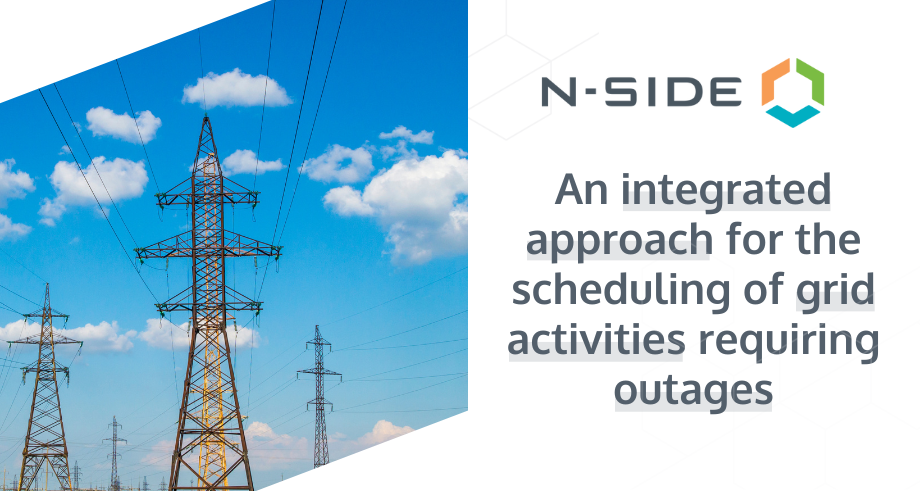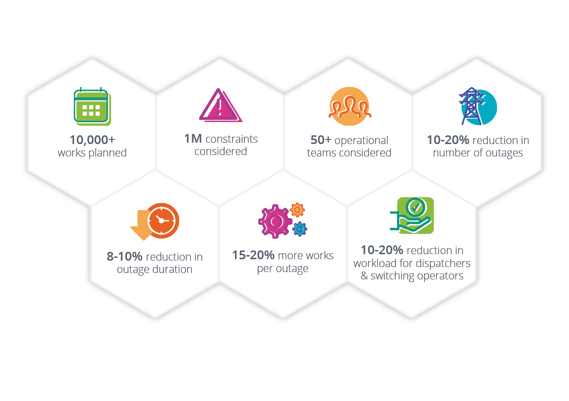Professional Services
Whether your challenge can be solved by our existing products or requires the development of new analytics solutions and market design approaches, our team is ready to help.
An integrated approach for the scheduling of grid activities requiring outages


 Maxime Hanot
Maxime Hanot
To achieve a sustainable and resilient future, we’re going to have to learn to tackle unpredictability in the power grid — and that requires novel approaches to decision making.
As energy systems become more complex due to the proliferation of renewable energy resources and decreased centralization, manual decision-making processes become less reliable.
Thankfully, advanced analytics solutions (including those leveraging constraint programming) are already supporting these processes and helping system operators achieve more optimal outcomes.
One area where advanced analytics is proving extremely valuable is in the scheduling of power grid maintenance and reinforcement works. Advanced analytics solutions can help system operators find an optimal schedule of grid activities to minimize outages and maximize investments and maintenance plans.
In this article, we’ll summarize our work on outage planning optimization. For an even more detailed look, check out the following resources:
Conference paper: An Integrated Planning Approach for the Scheduling of Grid Activities Requiring Outages | CIRED 2021
Webinar replay: From feasible to optimized outage planning: leveraging the power of Advanced Analytics at Elia Transmission Belgium
More network activities and fewer outage opportunities
Scheduling power grid maintenance is getting increasingly complicated. There is already a greater need for reshuffling schedules and adjusting plans due to the unpredictability of renewable energy production. We expect the work required to maintain assets to be significantly higher by 2030.
Right now, humans are still capable of making feasible decisions about maintenance activities and planned outages without the support of advanced analytics.
However, there is a gap between feasible and optimal, and advanced analytics solutions have been proven to help achieve more optimal outcomes. Due to increasing complexity, finding a feasible solution may not even be an option anymore in a few years.
An integrated approach to outage planning
N-SIDE and Elia (the Belgian transmission system operator, managing the grid from 380kV down to 30kV) partnered to create a holistic and integrated outage planning decision-making tool.
The tool, called OPSO (Outage Planning Support by Optimization), treats the problem of maintenance planning like a scheduling issue. It helps Elia optimally plan for grid activities requiring outages by finding the most optimal and efficient schedule, while taking into account all constraints and maintaining agility.
How does OPSO work?
OPSO’s goal is to determine the best starting day for outages based on various considerations, including the number of switching operations, length of outages, and business needs.
Once per year, OPSO determines the optimal schedule of maintenance activities requiring outages for all voltage levels for the subsequent year. Every week following (and even more often in some cases), OPSO updates the schedule up to the end of the current year to adjust for any changes.
One common problem with optimization solutions is a tendency to pursue optimal strategies under all circumstances, ignoring real-world challenges. OPSO accounts for this, taking into consideration user experience and the cost of making major changes to the schedule for only marginal benefits.
OPSO is a holistic solution. It takes into consideration time constraints, available resources, network constraints, and market constraints (avoiding impacting the price on cross-border markets).
The tool looks at all voltage levels, including the high-voltage transmission grid and medium-voltage regional grid. It also covers multiple time frames, including daily, weekly, and yearly perspectives.
Factoring all of this information into a manual process would be extremely cumbersome. Instead, advanced analytics handles all of the complexity, and the tool provides suggestions to operational planners who can then use their expertise to make optimal decisions.
Stability when possible, agility when necessary
N-SIDE and Elia’s outage planning optimization solution helps the system operator balance stability and agility. How?
Elia can use OPSO to see the impact of strategic changes before implementing them. By helping system planners simulate the impact of strategic decisions, OPSO lets Elia decide between a plan that utilizes more conservative numbers but requires fewer ongoing adjustments, or a lean plan that requires more replanning but reduces costs, length of outages, or some other variable.
No matter which plan Elia chooses, the system can help them implement it.
Results: The impact of advanced analytics on outage planning
Compared to manual decision making, OPSO has been shown to:
- Minimize risk to the grid and reduce the impact of difficult outages
- Minimize impact on the market
- Minimize operational costs
- Minimize total workload for planning and operational teams
- Increase the capacity to realize maintenance projects
- Maximize return on grid reinforcement investments
By the numbers:

Learn more about OPSO. Watch the webinar.



About the Author
Maxime Hanot holds a Master Degree in Mathematical Engineering from UCLouvain (Belgium). His fields of expertise are mathematical modelling, constraint programming, and (semi-)supervised learning. He is the product Owner of the N-SIDE Outage Planning Optimization solution for System and Network Operators as well as the technical lead for N-SIDE on the H2020 European project “FlexPlan”.
Maxime Hanot









